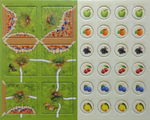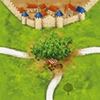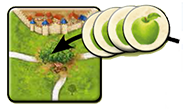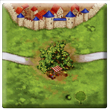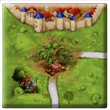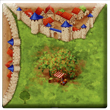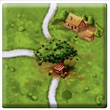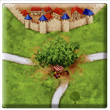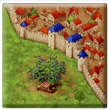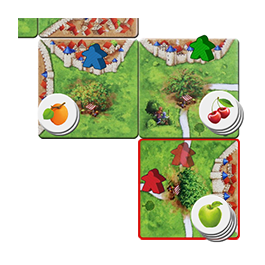Ovocné stromy
Úvod
S tímto rozšíření bude Carcassonne obklopeno různými ovocnými stromy. Čím větší bude vaše nabídka ovoce, tím vyšší bude váš příjem.
Rozšíření je hratelné pouze se základní sadou CARCASSONNE nebo kterýmkoli jiným rozšířením. Všechna pravidla hry zůstávají stejná. Zde jsou popsána pouze dodatečná pravidla k tomuto rozšíření.
Herní materiál
- 6 nových kartiček krajiny s 6 druhy ovocných stromů (kdoule, jablko, meruňka, třešeň, švestka a černý bez)
- 24 žetonů ovoce (4 žetony od každého ovoce s hodnotou 5, 4, 3, 2 na zadní straně)
Pravidla hry
Příprava hry
Nové kartiček s ovocnými stromy zamíchejte mezi ostatní kartičky hry. Žetony ovoce rozdělte podle jejich typu. Hodnotami dolů je srovnejte do šesti kupiček které umístěte vedle počítadla bodů.
Pravidla hry
1. Přiložení kartičky
2. Umístění figurky
Na kartičku s ovocným stromem můžete umístit figurku podle obvyklých pravidel. Není povoleno umístit figurku na samotný strom.
Provedení „akce s ovocem“
Pokud jste umístili figurku, můžete nyní provést jednu z následujících dvou akcí. Pokud hráč v pozdějším tahu přiloží kartičku sousedící (svisle, vodorovně nebo úhlopříčně) s kartičkou ovocného stromu a umístí na ni svou figurku, může také provést jednu z následujících dvou akcí. [1] [2] [3] [4]
- Harvesting
- Selling
Harvesting
Take the top-most fruit token from the tree tile (if available). Then, immediately score points according to the fruit token's value. The fruit token is then placed in front of you.
Selling
Instead of taking a new fruit token, you can choose to sell fruit tokens you have previously harvested. You may sell 1 to 4 tokens, but the more you sell, the more points you score. If you want to sell more than one token, they must (all) be of different types of fruit. You may only sell one set at a time. The value on the back does not matter when selling fruits. Sold fruit tokens are set aside and removed from the game.
| Points for fruit selling | |
|---|---|
 |
1 token = 3 points |
 |
2 tokens = 6 points |
 |
3 tokens = 10 points |
 |
4 tokens = 15 points |
The following examples show harvesting and selling actions:

Later you place a tile next to the apple tree again and you place a meeple. Now, you want to sell. Up to now, you have harvested 2 apple tokens, 1 apricot and one cherry token. You sell three different tokens for 10 points. As you are only allowed to sell one set at a time you keep one apple token.
3. Scoring a feature
When you complete one or more areas (e.g. a monastery, a road etc.) by placing a Tree tile, you score them according to the normal rules.
Final scoring
At the end of the game, each fruit token is worth 1 point.
Tile distribution
Total Tiles: 6
Several tiles have a small illustration on them. The letters in brackets show which illustration is on each tile:
Total Tokens: 24
For each fruit type, there are four tokens with different values (2, 3, 4 and 5) on the back.
Footnotes
For Icons explanation and licensing please visit Icons page.
- ↑
 A fruit action may happen when:
A fruit action may happen when:
- A tree tile is placed with a meeple (in the same turn); or
- A new tile with a meeple is placed adjacent to a tree tile (in a later turn). It does not matter who placed the tree tile.
- The rules require the placement of a meeple: The meeple placement can happen as first or second figure (the phantom). The placement of a special figure or a neutral figure or a token does not count.
- The fruit action is optional: A player may comply with the given requirements but decides not to perform a fruit action.
- ↑
 The interpretation of the original HiG rules suggests that a player may execute one fruit action per tree present on the newly placed tile or any adjacent ones and each meeple placed on this turn part (up to two if placing a any meeple plus a phantom). An official clarification would be necessary.
The interpretation of the original HiG rules suggests that a player may execute one fruit action per tree present on the newly placed tile or any adjacent ones and each meeple placed on this turn part (up to two if placing a any meeple plus a phantom). An official clarification would be necessary.
- ↑
 The rules to trigger a fruit action require the direct placement of a meeple during phase 2. Placing a meeple on the tile just placed. This will rule out other meeple placement mechanics:
The rules to trigger a fruit action require the direct placement of a meeple during phase 2. Placing a meeple on the tile just placed. This will rule out other meeple placement mechanics:
- Placements to other tiles but the one just placed during the right phase:
- Magic portals (Exp. 3 - The Princess and the Dragon)
- Acrobat placement on an adjacent tile (Exp. 10 - Under the Big Top)
- Flying machines (Mini #1 - The Flier (Flying Machines))
- Placements to the tile just placed during other phases:
- Wagon movement (Exp. 5 - Abbey and Mayor)
- Deployment from the City of Carcassonne (Exp. 6 - Count, King and Robber)
- Crop circles (Mini #7 - Crop Circles)
- Deployment to a bathhouse (The Barber-Surgeons)
- Placements to other tiles but the one just placed during the right phase:
- ↑
 Note that fruit actions take place during phase 2. Placing a meeple. Therefore, these actions will happen as usual even if later actions in the turn sequence may remove the meeple from the tile, for example, being eaten by the dragon (Exp. 3 - The Princess and the Dragon).
Note that fruit actions take place during phase 2. Placing a meeple. Therefore, these actions will happen as usual even if later actions in the turn sequence may remove the meeple from the tile, for example, being eaten by the dragon (Exp. 3 - The Princess and the Dragon).
- Editor Manual - Old numbered parameters - RulesPlacingTile
- Editor Manual - Old numbered parameters - RulesPlacingMeeple
- Editor Manual - Old numbered parameters - RulesScoring
- Editor Manual - Old numbered parameters - Tile
- Checked
- Second Edition
- Second Edition Minor Expansion
- Old template
- Old template - FootnoteIconPara en
